ResearcHStart Promotes the Next Generation of Scientists by Exposing Local High School Students to Cancer Research
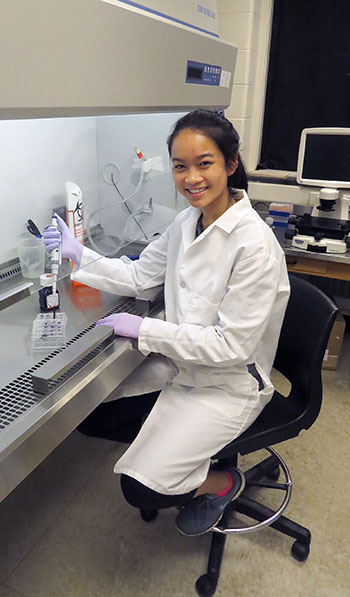
Joy Chen at work in Professor Erik Nelson's lab (photo courtesy of Ashley Lawrence).
May 9, 2018
When the American Cancer Society discontinued its program exposing high school students to cancer research in laboratories, philanthropists Deborah and Ira Cohen, he's an Illinois CS alumni and she's a huge advocate for cancer research, said to each other: “I wonder if we could do something about that?” So they did. In 2015, they began researcHStart, a program which allows Illinois high school students to discover what a career in cancer research might be like via authentic research experiences in cutting-edge laboratories at Illinois and other campuses in the state.
To ensure that Champaign-Urbana students had a chance to experience cancer research at his Alma Mater, the Cohens reached out to Rohit Bhargava, Illinois Bioengineering professor and Director of the Illinois Cancer Center to be one of the founders, and researcHStart at Illinois was born. Originally implemented at the University of Illinois at Urbana-Champaign (Illinois), University of Illinois at Chicago, and University of Chicago, the program recently added a fourth partner, Northwestern University in Chicago.
The main emphasis of researcHStart is to give high school students from Chicago and Champaign-Urbana the chance to explore careers in cancer research by working full time in the laboratories of established cancer researchers on a nearby campus. Students not only gain hands-on experience in areas at the forefront of cancer research, but experience rigorous research training, lectures by cancer research faculty, and also network with faculty and mentors dedicated to helping them grow as researchers.
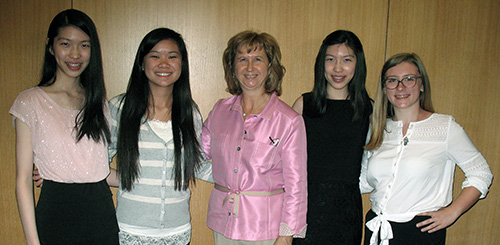
Debra Cohen (center) with the 2015 researcHStart at Illinois participants. (Photo courtesy of the Cancer Center at Illinois website.)
In addition, ResearcHStart may also be impacting the number of underserved students (especially women) in the field. For example, at Illinois, a large number of researcHStart students have been females. In the first year, all four students were female; in 2016, there were four males and one female; in 2017, six were females while two were males. And the incoming 2018 cohort is six females and one male.
Of course, the main focus of Illinois' researcHStart program is students getting to experience research with some of Illinois' world-class faculty on the cutting edge of cancer research.
“Our faculty are just amazing,” says Paloma Pearson, Coordinator of Illinois’ researcHStart program, referring to the eight faculty who currently participate. From five quite diverse departments (Animal Sciences, Bioengineering, Electrical and Computer Engineering, Molecular and Integrative Physiology, and Food Science and Nutrition), they are all part of the Cancer Center at Illinois.
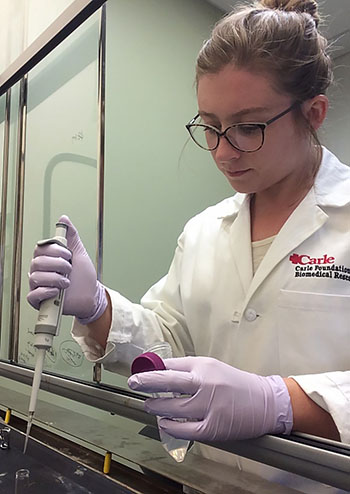
2015 researcHStart participant, Callie Miller, in the lab at the Mills Breast Cancer Institute at Carle Clinic. (Photo courtesy of the Cancer Center at Illinois website)
And just as diverse as their departments is the cancer research they do. “It’s not all putting cancer cells in a petri dish and pipetting,” Person says. There are animal models, computer simulations, dialectics, and bioimaging. She says the program hopes to fly in the face of the notion that cancer research is: “A white lab coat, and I’m going to sit there with my little pipette—that’s not how science is, especially at this university with such a focus on engineering. It’s not the only way to do cancer research,” Pearson explains.
So the program seeks to expose students to the breadth of cancer research that’s available. “If you haven't been exposed to it, or if you think science isn't your forte, you might not know that all this happens,” she admits. “I think they really want to promote the next generation of scientists.”
Participants also experience career development and skill-building workshops. “Part of the program is not just sitting in a lab doing work,” explains Pearson, “but it’s also doing professional development so that the students can get a little bit more of a feel what it is like to read an academic research paper and how you bolster your resume.”
To expose participants to another important aspect of research—sharing it with the public—students get to present their research to family, friends, and members of the scientific community at an end-of-the-summer research symposium at one of the partner universities. Plus, in addition to all of the other benefits, students receive a $2,000 stipend for the summer.
Agreeing that the research symposium experience was quite beneficial in terms of enhancing her presentation skills is Illinois Bioengineering freshman Joy Chen, who participated in researcHStart in 2017, the summer following her senior year. “Through this program, I could go through a project from the beginning to the end and have results that I could present. I had the opportunity to give an oral presentation at the symposium at the end of the summer, and being able to share what I did with my peers as well as professors at the university was an amazing experience.”
Chen’s research with Professor Erik Nelson in the Department of Molecular and Integrative Physiology focused on the effects of cholesterol on breast cancer metastasis. Thus, in addition to presentation skills, she learned various foundational experimental techniques: how to use imaging technologies, plus basic lab protocols, such as RNA extraction or polymerase chain reaction. She also learned how to work with animals:
“One of the most valuable and memorable experiences I had over the summer,” Chen reports, “was being able to test our hypothesis in mice. I learned how to inject, treat, and do surgery on mice. I got to use the imaging machines we have over at the Beckman Institute to check on how our mice were doing every week, which was fascinating to see.”
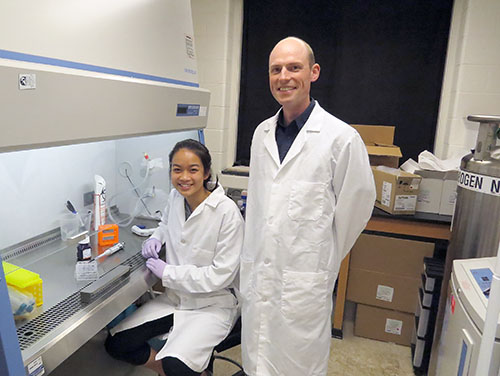
ResearcHStart participant Joy Chen with Professor Erik Nelson in his lab at Beckman (photo courtesy of Ashley Lawrence).
For Chen, another unique aspect of her researcHStart experience is that it didn’t end last summer: “I have been fortunate enough to continue working in Dr. Nelson’s lab this past semester,” she adds. “Going to lab is always something I look forward to because it’s a nice break from my classes and homework. I find it exciting that I get to do research as just a freshman, working towards a larger goal that can impact the real world.”
Regarding the opportunity that former researcHStart students who matriculate to Illinois have to continue working in their labs, ResearcHStart Coordinator Pearson is particularly pleased about it. “One of the really cool things that we’ve seen is that there’s this continuation,” she explains.
So what’s the program’s vision as a whole? That some participants might end up choosing careers in cancer research. Most high schoolers’ career choices for the future are pretty narrow—the traditional doctor or lawyer—but Pearson sees researcHStart as broadening their career possibilities.
“This gives them a taste of what you can actually do at a university,” she explains, “what kind of lab work exists, but also just how fun, hard, challenging, and exciting science is. I'm married to a scientist, so I get to hear all about it.” (Her husband is a postdoc at IGB working on…cancer research.)
Has researcHStart possibly convinced some participants to consider careers in cancer research? According to Pearson, of the eight students in last year’s cohort, five originally wanted to be medical doctors. In fact, she says the interview panel faculty commented: “They want to be a doctor. Do we really want them in a lab doing research?” However, by the end of the program, some had either they dropped the idea entirely, saying, “I don't necessarily know if I want to be a physician; I’d love to do research,” or suggested, “Maybe I’ll do both, do an MD and PhD.”
This is the career goal of Joy Chen, whose plan after college is to continue on to an MD/PhD program. “I think the research and implementation are both key to creating new therapeutics,” she admits, “and I want to be a part of both of it. I want to see the research that I do to eventually get applied to engineering to create solutions and develop the medical industry even more.”
And while researcHStart didn’t impact Chen’s decision to come to Illinois (she was already committed to Bioengineering at Illinois prior to that), she says her experience here definitely solidified her decision.
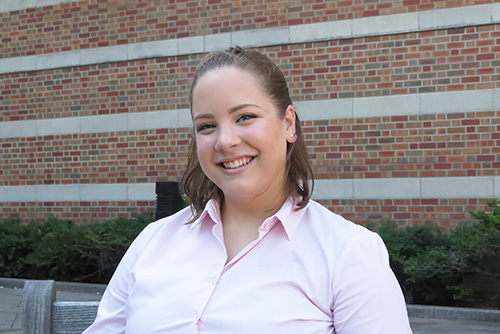
Elizabeth Breen (photo courtesy of Ashley Lawrence).
Such was the case for another of last summer’s participants, Elizabeth Breen, currently a senior at University Laboratory High School. She plans on majoring in Integrative neuroscience in college, then pursuing either an MD or MD/PHD. Breen says her research experience helped to confirm her career path.
”I knew I was sort of interested in neuroscience, but I think this really strengthened and made me sure that that was the field I wanted to go into. Because, the brain—there's so little that we know about it, and there's so many different ways that you can go really in depth into different areas of it. It's one of the fastest-growing areas of science, and I'm excited to be a part of that."
Breen worked with Animal Science Professor H. Rex Gaskins at an IGB lab studying the protein CHCHD2 in the mitochondria of animal cells. "We were seeing if knocking it out of cells would have any effect on cell respiration, specifically in human brain cancer cells.” Did it? Breen says yes, cells with the protein knocked out were less viable. "Getting rid of it is good when you're trying to treat cancer cells," she acknowledges.
Breen got involved with researcHStart because she wants to do research during her college career. “I wanted to get sort of a head start on working in a lab,” she says. Also, because neither of her parents are in STEM, and students sometimes need connections to land a prestigious research position in college, she also thought it would look good on her resume.
“I thought researcHStart was a great opportunity because I was going to get to do my own project, and work with a Ph.D student and a professor actually putting forward my own work to help the lab. So that was really what drew me to it…just being able to apply for a program like this and let my own work speak for myself.”
Breen was also happy to be a part of this program because of its impact once she's in college. “It was, honestly, one of the best experiences I've had in my high school career, and I think it's put me ahead of a lot of my peers as far as being able to get these opportunities in college when I've already had this research under my belt.”
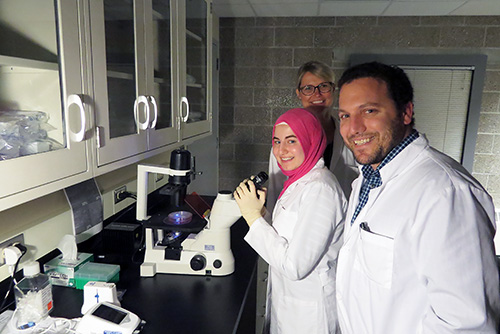
Left to right: 2017 researcHStart student, Malaak Saadah and her mentors Postdoc Kathrin Bohn-Wippert and Professor Roy Dar (photo courtesy of Ashley Lawrence).
Malaak Saadah, a senior at Champaign Central High School also participated in researcHStart the summer of 2017. Her study in Professor Roy Dar's lab on the proliferation and viability of cancer cells and bystander cells when treated with anticancer drugs was her first research experience.
Skills Saadah gained during her research experience included learning how to use the lab equipment; basic lab protocols; plus how to grow, count, and store cells, which she calls “really cool.” She learned the importance of lab hygiene, and keeping all equipment sterile and clean, “otherwise research results become inaccurate.” Another skill she gained was how to analyze and organize data. Working with cells and numbers all day, she reports being “taught how to organize the information I was analyzing to make it easier to understand and interpret later on.”
Plus, she learned how to efficiently present her results in front of an audience. In fact, Dar and the lab members taught her how to effectively present her results to an audience who didn’t necessarily work in this field. “I think that's a very important skill and can be adapted to all aspects of my day, even as a student at school,” says Saadah.
Although she’s probably not going into cancer research (she’s studying Civil Engineering at Illinois) she believes her experience did impact her decision because she learned more about the overall research process. “It made me more curious about the simple things, she says. “The research that I did was in Bioengineering and although I enjoyed the learning process and the knowledge I gained, it made me realize that I'm also very intrigued in large-scale research as well.”
Future prospects weren’t the only thing that changed over the summer. “It's interesting to watch these kids come out of their shells,” Pearson acknowledges. She calls many of the top-of-their-class participants “nerds and incredibly quiet.” But by summer’s end, most have newfound confidence. She relates an anecdote about one quiet student, who when he got up front for his oral presentation at the symposium, “He just talked, and he was animated; he was excited; he just seemed like a completely different person!”
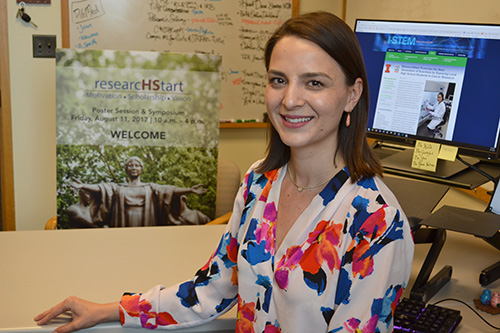
Paloma Pearson, Coordinator of Illinois’ researcHStart program.
And students become more confident in areas other than public speaking. Pearson says participants enter the program inexperienced but leave research savvy. “You get this high schooler—I know if I were faculty, I’d think, ‘Oh, no, I’m going to have to baby sit this kid!’—There’s this kid; most of them aren’t 18, and they come in super scared, kind of unknowing of things. By the end of it, they’re saying words that I can’t pronounce! And they actually really understand what the science is.”
Pearson says another rewarding thing is watching the participants’ transformation from children to adults. “You watch them grow up in eight weeks,” she reports. “I treat them like adults. You see them build their confidence. They’re working 40 hours a week. They’re treated like colleagues...but you watch, and these become partnerships.
She adds that in high school, kids don't necessarily get those dynamics. "You’re still with your parents; you have that kind of hierarchical feeling of, ‘Oh, you’re the boss; you tell me what to do.’” But the researcHStart dynamic is different. "They say, ‘No, you’re an adult, and if not, you’re going to be an adult very, very soon, and we need you to act like adults, and work like adults, and be adults!’ And you realize, everybody steps up to the challenge. And it’s really, really fun!”
Parents are astounded by their kids’ progress too. She compares parents watching their kid standing up there presenting at the symposium to “deer in headlights,” with almost a “Who is this, and what have you done with my child?” reaction. Parents have come up to her saying, “I had no idea! How can we continue this? Are there additional programs?’”
Another indicator of the program’s positive impact? Proud of their achievement, afterwards, students have requested, “Can we have our poster?” Pearson believes they’re probably on a wall in some dorm room.
She says researcHStart gives students “the responsibilities that they're going to have to have as an adults a few months to a year of them leaving the lab. That's what you give them. You empower them to be those independent individuals and investigators that a lot of them didn't know they could be. They had the idea that maybe they could do this, but could they actually do the work and deliver? They do, and it's amazing!”
Regarding the job skills gained via the program, Breen concurs: “It also taught me a lot about what people expect of you when you're working, and how different dynamics work when somebody assigns something to you, and then you complete it to the best of your ability...It's like a real job, and I've never had something like that before. I was just 16/17 last summer. So it was a lot of pressure, but I think it was great that it gave me the opportunity to sort of rise to that occasion.”
For Pearson, what’s most rewarding about researcHStart is that it “brings together a group of people who have been mostly sheltered their whole lives, and brings them into the world and says, "Grow!" I'm throwing you into something; you have eight weeks to figure this out, and only about six of them to actually do work, and do something amazing!’ You really do watch them going from a little tiny caterpillar to a beautiful person on the other side.”
Story and photographs (unless otherwise noted) by Elizabeth Innes, Communications Specialist, I-STEM Education Initiative
For more related stories, see:
BioE, Funded, Summer Research Programs, 2018
For additional istem articles about cancer research experiences, see:
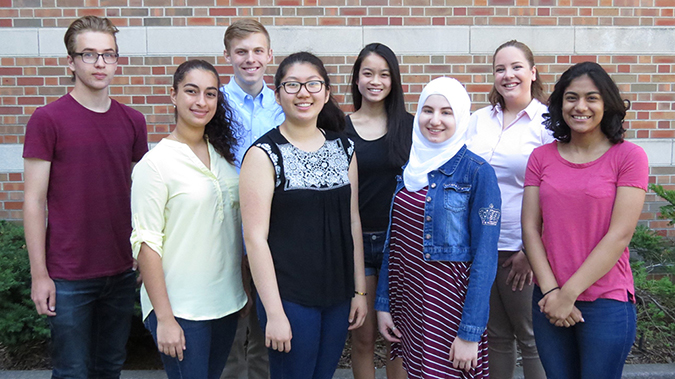
2017 researcHStart students: Back row, left to right: Robert Forsyth, Jarron Roy, Joy Chen, Elizabeth Breen. Front row, left to right: Sarah Matatov, Yichen Yao, Malaak Saadah, Aditi Mehta.(photo courtesy of Ashley Lawrence).













.jpg)
















